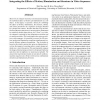Free Online Productivity Tools
i2Speak
i2Symbol
i2OCR
iTex2Img
iWeb2Print
iWeb2Shot
i2Type
iPdf2Split
iPdf2Merge
i2Bopomofo
i2Arabic
i2Style
i2Image
i2PDF
iLatex2Rtf
Sci2ools
ICCV
2005
IEEE
2005
IEEE
Integrating the Effects of Motion, Illumination and Structure in Video Sequences
Most work in computer vision has concentrated on studying the individual effects of motion and illumination on a 3D object. In this paper, we present a theory for combining the effects of motion, illumination, 3D structure, albedo, and camera parameters in a sequence of images obtained by a perspective camera. We show that the set of all Lambertian reflectance functions of a moving object, illuminated by arbitrarily distant light sources, lies ”close” to a bilinear subspace consisting of nine illumination variables and six motion variables. This result implies that, given an arbitrary video sequence, it is possible to recover the 3D structure, motion and illumination conditions simultaneously using the bilinear subspace formulation. The derivation is based on the intuitive notion that, given an illumination direction, the images of a moving surface cannot change suddenly over a short time period. We experimentally compare the images obtained using our theory with ground truth dat...
Bilinear Subspace | Computer Vision | ICCV 2005 | Illumination Directions | Illumination Variables |
| Added | 24 Jun 2010 |
| Updated | 24 Jun 2010 |
| Type | Conference |
| Year | 2005 |
| Where | ICCV |
| Authors | Yilei Xu, Amit K. Roy Chowdhury |
Comments (0)

